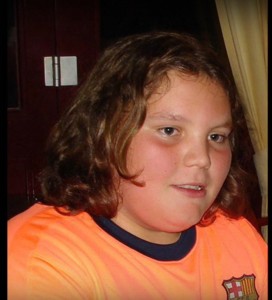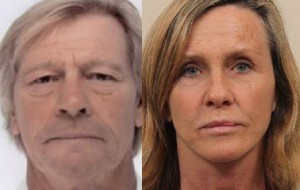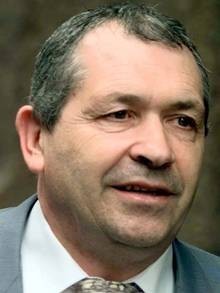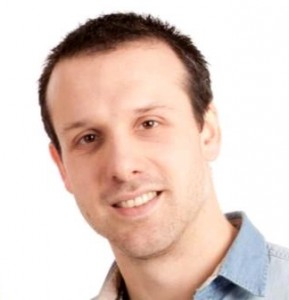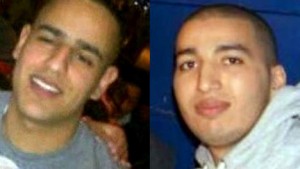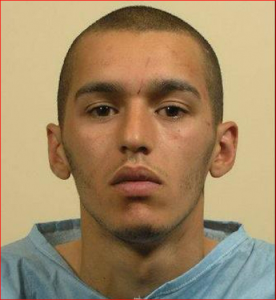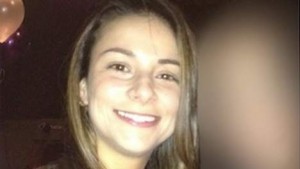Category Archives: organised crime
So the merry-go-round begins again……
ORGANISED crime boss Robert Dawes has been arrested again following a warrant issued by the French authorities.
This week officers from the elite organised crime unit of Guardia Civil based in Madrid arrested the 43-year-old Nottinghamshire man and searched his villa in Benalmadena, Mijas Costa.
It is unclear yet what the specific charges relate to and what other arrests have been made, but the request has come from a court in France which is believed to be investigating a large-scale drugs shipment which came through its borders.
The operation involved the co-operation of the National Crime Agency in the UK and their French counterparts OCRTIS.
A spokesman for the National Crime Agency said: “Robert Dawes was arrested in connection with international drug trafficking as part of a joint investigation between the French OCRTIS, the NCA and the Guardia Civil.”
I have previously written at length about the bureaucratic bungles and corruption issues which have resulted in Dawes thwarting the authorities efforts to make charges stick against this “Teflon Don“.
Indeed a Spanish investigation into a 200 kilo shipment of cocaine linked to Dawes, fell apart after vital evidence including mobile phone sim cards and computer data seized in Dubai, which should have been presented to the Spanish judge Jose Santiago Torres, was handed back to Dawes’ wife via Spanish police officers. That loss of evidence, mistaken or consciously planned, alongside a lengthy delay from the British authorities to submit their own evidence, has been blamed for Dawes release from custody four years ago. The combination effectively ended the case against him in 2012. Dawes – who has ready access to a number of false passports – is known to have the ability and funds to corrupt police officers and key components of the justice system, according to those who have investigated him in law enforcement.
Now three years on the Daily Mail reports that Dawes is once again in custody in Madrid this time to await an extradition hearing which could take him to a cell in France. However the case will be watched closely by the authorities in Netherlands and the UK. Dawes was named as the man who ordered the murder of innocent Dutch school teacher Gerard Meesters in November 2002. At the time of the court case, which saw the cartel’s footsoldier Daniel Sowerby jailed for life, the Dutch authorities lacked a final piece of evidence to charge Dawes with ordering the murder. In the UK, aside from the overwhelming prima facie evidence linking him to shipments of class A drugs here, British authorities still regard Dawes as a “person of interest” linked to the October 2002 assassination of Nottinghamshire businessman David Draycott.
We shall, of course, follow the merry-go-round of developments with great interest.
The beginning of the end for the crime family dubbed the A-team
AT AROUND 4pm last Friday a well-heeled couple sauntered down the pretty canal-lined streets which run parallel to Amsterdam’s Dam Square.
To most people they would have appeared to be nothing more than two of the thousands of middle-aged tourists enjoying a spot of afternoon window shopping on holiday in the Dutch capital. But when armed Dutch police officers swooped and arrested the couple as they reached Mosterdpotsteeg junction with Spuistraat, it was clear they were no ordinary tourists.
Dutch police had just detained 59-year-old Patrick “Patsy” Adams and his 55-year-old wife Constance, senior figures in the notorious Adams crime family from North London dubbed the A-Team. He was on the run and Britain’s most wanted.
In April this year, the Metropolitan Police quietly applied for a European Arrest Warrant to be issued against the couple in connection with the shooting in broad daylight of a former A-Team enforcer called Paul Tiernan on December 22 2013 in Clerkenwell. Despite gunshot wounds to the chest, Tiernan survived the attack and went on to later deny “one million percent” that Patrick Adams was behind the shooting.
The following month, the Met, having successfully applied for an arrest warrant, went public and issued photographs of the couple saying they were on the run, with the possibility they could be in Spain or Netherlands. Rumours subsequently abounded that they had in fact fled to Cyprus.
Alongside his brother Terry Adams, Patrick or Patsy as he often known, occupies a position at the very top of a well-oiled organised crime group which has brought terror to the streets and exercised a power which has even brought them to the attention of MI5 on the grounds of threats to national security. The A-team has been linked, since the early 90s, to more than 25 murders. In addition they have been involved in large shipments of class A drugs over three decades, and a myriad of other criminal enterprises from corruption and extortion to property fraud and money laundering.
The background to the arrest of “Patsy” and his wife is even more astonishing, if to be believed. According to the statement of the Dutch police , Adams and his wife were spotted wandering down Spuistraat by a police officer from the first floor of an overlooking police station. The officer, apparently specially trained in techniques of facial recognition, immediately linked Mrs Adams with photographs of the couple which had been distributed by British Police in May. The officer radioed to colleagues on the ground to follow the couple and ascertain if it truly was Britain’s most wanted. Shortly afterwards they were arrested and also linked to a safe house nearby which has been raided by the police and items seized.
A far more likely scenario is that British police had already tracked Adams through either sophisticated telecommunications or inside information and knew exactly where he was, and believed an arrest on the street would be safer having already ascertained where Adams was holed up. A knowledgeable source speculated: “In the war on organised crime it always helps if your enemy remains in the dark about the tools at your disposal. It would not be the first time that a cover story, if that is the case, has been produced to protect the back story to a high-profile arrest like this. If not its one of those one in a million chances that does sometimes happen.”
Another anomaly is that despite having clearly been informed the Met were on his trail, Adams thought Amsterdam was a safe haven. Adams could have chosen any one of a number of locations to lay low which do not have extradition agreements in place with the UK. Instead he chose one of the very locations police had flagged up as Adams’ potential sanctuary – perhaps Adams believed “the flat place”, as its known in criminal circles, was safe because the police had gone public. Either way Adams must have known that co-operation between the British and Netherlands in cases such as this is extremely tight and will now have to shuffle his pack of cards like a magician to avoid being flown back to the UK in handcuffs.
According to Dutch sources the couple have indicated they are going to fight extradition to the UK. Dutch judges will have to rule on the application from the UK within the next three months.
There was more bad news for the A-Team. On the day the Met announced Adams and his wife were in custody in Holland, they also announced a raft of criminal charges against a number of other members of the A-Team including Patrick’s younger brother.
Michael Adams, 50, and his partner Deborah Heath, 48, were charged following series of raids carried out by Scotland Yard and HM Revenue and Customs, mostly across the north of the capital last year.
Adams was arrested at his Finchley home in April 2014 as part of Operation Octopod when more than 100 police and customs officers raided properties across the capital and south east.
He is charged with four offences of converting banknotes, knowing they were obtained from crime, falsely stating his income for tax purposes and two charges of money laundering.
Heath, who was arrested at the same time is charged with the money laundering offence of concealing banknotes.
Four others were also charged including retired chartered accountant Rex Ekaireb, 67, of Hendon, is charged with intent to defraud HMRC. It is claimed he falsely stated the level of income Michael Adams received for “consultancy work, commissions and introduction fees”.
Ekaireb’s son Robert, a property developer, was recently jailed for life for the murder of his Chinese wife Lihau Cao, whose body was never discovered. Police believe Robert Ekaireb was close to the A-team and had phoned Adams’ family associates at a West End club controlled by the A-team for help disposing of his wife’s body on the night of the murder.
His father Rex Ekaireb is also charged with converting criminal property to launder cash. Four others are also charged under the Proceeds of Crime Act. All six charged have been bailed to appear at Croydon Magistrates Court in October. 22 others arrested at the time of Operation Octopod remain on bail.
It seems that finally last orders may be about to be called on the A-team as police begin to fragment this tight organised crime group which has brought so much fear to the capital and spilled so much blood.
Goldfinger: A spider’s web of stealth, wealth and death..
By Carl Fellstrom, Tom Worden and David Connett
A top-secret surveillance operation monitored gunned-down timeshare fraudster John “Goldfinger” Palmer for at least eight years up until his death two weeks ago, it can be revealed.
The British operation, which drew upon listening devices placed by Spanish law enforcement, amassed a treasure trove of intelligence on organised crime figures from at least 2007. Fears about the operation being compromised by corrupt police officers resulted in it being established at a remote RAF base in the north of England.
A four-man team, some of whom retired during the course of the operation but were kept on for operational and secrecy reasons, was fed a daily diet of information about Palmer’s meetings and associations as he flitted around the globe and between Britain, Tenerife and mainland Spain.
Essex detectives investigating Palmer’s killing have requested help from the Spanish authorities about possible motives and suspects. It can also be revealed that Palmer, found dead in the garden of his Essex home in June, was shot in the chest and leg by a low-calibre weapon firing ammunition designed to cause maximum fragmentation inside the target.
The assassin had cut a hole out of a panel in the fence that surrounded the dead man’s secluded garden. Police have removed the panel for further examination.
The surveillance operation was based at an unlisted office within RAF Spadeadam, on the borders of Cumbria and Northumberland. The intelligence gleaned from the surveillance of Palmer and his associates led to a myriad of other operations being set up.
They picked up Palmer doing business with crime bosses from the UK, Russia, Romania and Spain, and created an intelligence file that read like a who’s who of organised crime, according to sources.
One former intelligence source with the Serious Organised Crime Agency, forerunner to the National Crime Agency, said: “They were being fed intelligence by the Spanish including phone calls and other surveillance material. It was kept as quiet as possible because of fears about corruption issues within British law enforcement, and legal issues surrounding the operation’s involvement with the Spanish and the obtaining of intelligence from those bugs.”
Palmer was charged with money laundering and fraud in Tenerife in May and was on bail. He was reputedly worth £300m, but investigators believe that figure was greatly exaggerated. In May 2005 he was declared bankrupt and all his assets, including seven timeshare resorts, were taken over by a trustee in bankruptcy. British police believe a number of his assets were taken over by the Adams family, the north London crime gang.
Spanish investigators tracking down Palmer’s assets found he owned a complex network of 122 companies, many offshore in the Isle of Man, Madeira and the British Virgin Islands, as well as 60 offshore bank accounts. The accounts were seized and the timeshare resorts were sold off for approximately £30m, mostly to Russian investors.
Palmer was sued in a group action by many of his thousands of victims and was ordered to repay them £4m.However, Spain’s tax authority seized the bulk of the money raised from the asset sales, leaving his victims with little prospect of recovering their money. He also spent around £5m in legal fees.
A source on the financial investigation estimated the criminal’s fortune to be nearer to £50m. The source said: “Palmer said he blew a huge amount of money in the 1990s on cocaine and girlfriends. He had a massive cocaine habit and the lifestyle to go with it – the private jet, the yacht, the Ferraris.
“He had four or five girlfriends at any one time, and would fly around the world on his private jet, to Barbados, Russia, the US, Germany, France, Switzerland. He also said he spent a fortune paying off judges, police officers and politicians in Tenerife.
“He said he once flew a private jet back from Russia full of cash. He was stopped at Madrid airport and bribed a policeman with a suitcase full of cash to turn a blind eye. Palmer had millions coming in in cash but blew millions at the same time. He used the 60 offshore accounts like personal bank accounts. His finances were complete chaos. So much of his business was done in cash, there was always a mountain of cash lying around in his Tenerife office. Literally stuffed in suitcases or lying around the office. He never paid tax and thought he would get away with it by bribing officials.”
Palmer’s yacht – Brave Goose of Essex – seized by a Spanish court in 2001, is worth much less than its reputed £1m value. An expert valued it at £400,000 but said it would cost £250,000 to make it seaworthy. “If you untied it from the dock it would sink,” the source said. Palmer’s collection of classic cars from the 1940s and 1950s, worth around £500,000, was allowed to corrode in the sea air in a Tenerife pound.
While Palmer was declared bankrupt and was officially broke, his partner Christina Ketley, who he met when she worked for him as a timeshare rep in the 1980s, was not. The house in South Weald, Essex, is in her name as is a two-storey flat overlooking the sea in south Tenerife. Ms Ketley, 55, is a director of seven companies in Spain and five in the UK. Prosecutors recently tried, but failed, to have her assets frozen.
She is facing fraud and money-laundering charges in Spain, and could be jailed for up to eight years if convicted. Last week prosecutors said they expect the case against her and nine others, including two of Palmer’s nephews, to go ahead at Madrid’s National Court.
Prosecutors alleged Ms Ketley ran Palmer’s business while he was jailed in the UK (he was sentenced to eight years for fraud in 2001, serving four). Sources close to Palmer insist he had no intention of pleading guilty to charges in Spain and a senior prosecution source described suggestions of a plea bargain as “pure fantasy”.
A defence source said Palmer vigorously denied the charges and had no intention of pleading guilty. He was due to fly to Madrid for a defence strategy when he was murdered.
The source said: “John Palmer was not a grass and he had no intention of becoming one. We believed there was every chance the case against him would have been thrown out.”
Before his death, friends say he was helping Ms Ketley run her Tenerife restaurant. He had his bail varied to return to Britain for surgery.
Turkish gang charged over UK’s largest cocaine seizure off Scottish coast
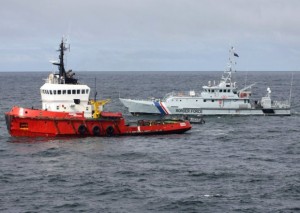
MV Hamal boat is intercepted by Border Force and Royal Navy vessels last week. Nine Turkish men have been charged
IN what appears to be the largest single seizure of cocaine in the UK, the authorities have charged nine Turkish men as part of the smuggling probe into more than three tonnes of the drug.
The nine men, aged between 26 and 63, all appeared before Aberdeen Sheriff’s Court yesterday, charged with possession of a controlled drug after an operation last week which saw the tug they crewed, MV Hamal, intercepted by Royal Navy and Border Force vessels.
The operation followed a tip off from the French customs after the tug, registered to Marshall Islands company Kiev Shipping and Trading Corporation, and flying a Tanzanian flag, was spotted 100 miles off the Scottish coast heading for Hamburg port. The German port has in recent years become a mirror to Antwerp as a shipping gateway for the introduction of South American cocaine into Europe. French sources believe the drugs could have been loaded onto the vessel in the Canary Islands early in April where it had docked.
Officers from the National Crime Agency working in conjunction with Police Scotland and the Royal Navy boarded the boat and brought it ashore to Aberdeen last week. French sources have estimated the seizure at more than two tonnes with a search of the boat continuing for several days.
The largest previous UK seizure of cocaine was in May 2011 in Southampton when a 1.2 tonnes load connected to Dutch-moroccan gangster, Samir Bouyakhrichan, later assassinated in Marbella, Spain, was seized from a luxury cruiser.
Though searches of the boat are expected to be completed by tomorrow, the load seized in Aberdeen could amount to as much as the total 2.4 tonnes of cocaine seized in the UK for the year 2011/12.
Seven men from Istanbul appeared in court yesterday.Mustafa Ceviz, 54, Ibrahim Dag,47, Mumin Sahin, 45, Mahammet Seckin, 26, Umit Colakel, 38, Kayacan Dalgakiran, 63, Emin Ozmen, 50, were remanded in custody along with two men other Turkish men arrested on the boat; Abdulkadir Cirik, 31, from Mersin, and Mustafa Guven,47, from Yozgat. Investigations are continuing into the gang behind the smuggling plot.
This seizure comes just 10 days after 2.25 tonnes of cocaine was seized from a yacht off the Martinique, the largest ever by French customs, in an operation which also involved the National Crime Agency.
In the past year large scale cocaine and heroin shipments which have been intercepted by the authorities have led to crime gangs in Netherlands, with links to Turkey and Morocco, executing a series of assassinations of significant gang members across the globe in an apparent power struggle.
UPDATE: Since this article was published, the National Crime Agency has confirmed that the drugs amount to more than three tonnes with a value in excess on the street of more than £500 million see National Crime Agency
The bloody cocaine trail running through the Amsterdam Killing Fields
STEFAN Eggermont was just pulling into a parking space in the dimly lit street near his Amsterdam home when the assassin came. Death came swiftly and without mercy or recognition. It was a “settlement of business” and the usual omerta code of silence would follow.
The 30-year-old father-of-one arrived in Conrad Street in his blue Fiat Punto at around 1.40am after spending the evening with brother Jordi watching Netherlands beat Brazil 3-0in the World Cup third place play-off in July this year.
Almost as soon as Stefan shut down the engine and opened his car door the assassin was upon him, riddling him with automatic gun fire. But Stefan was no gangster, he was a well-liked man working hard as a customer service manager at a web-based marketing firm. His only crime was that he lived near to and drove the same make and colour of car as the intended target.
He had become the first civilian casualty in a bloody war currently raging between two Dutch gangs over a missing £14 million cocaine shipment most of which was destined for the UK, which has now claimed at least 14 lives. When death came for him swiftly that evening Stefan was yards from his home where his partner and three-year-old child were waiting for him and yet he was in the wrong place at the wrong time. Finding no criminal or other motive in Stefan’s back story, Dutch detectives now believe the intended target was the brother of a man caught up in the feud, who drove the same car, lived nearby and often used Stefan’s parking spot.
According to Openbaar Ministerie, the Dutch justice ministry which is investigating the murders, the origin to this river of blood spills from a stolen batch of cocaine in the early part of 2012, when a gang known as the Turtles, ripped off a Dutch gang in the Belgian port of Antwerp. In March of that year customs in Antwerp seized 200 kilos of cocaine but unknown to them at the time, it was only part of the load. They believe now a batch of the drug had been stolen and had begun turning up in kilo amounts, selling for a lower than usual price.
The British Connections
At least two of the victims had links to a British gangster currently at large, named Robert Dawes, who in documents written by the Serious Organised Crime Agency, has been described as a “highly significant international criminal wanted for murder in Holland and drug importation in the UK”. Dawes was named in a Dutch court as the man who ordered the murder of innocent Dutch schoolteacher Gerard Meesters in November 2002.
Mr Meesters had been targeted because the criminals believed his sister Janette and her friend Madeleine Brussen had absconded with a shipment of drugs belonging to Dawes. Dutch phone taps later picked up the British gang saying the “fucking Thelma and Louise” pair had been taught a lesson and someone had paid with their life. British man, Daniel Sowerby, a foot soldier of the Dawes Organised Crime Group, is currently serving life for the shooting but he refused to say in court who had given the orders for fear of reprisals against his own family in the UK.
Wouter Laumans, respected Dutch crime journalist and co-author of recent book “Mocro Maffia”, charting the rise of the new Dutch Moroccan organised crime gangs explained: “The seizure In Antwerp was not reported in the media until recently so the gang thought all of it had been ripped. Then all hell has been let loose. There is no doubt in my mind that a lot of this cocaine was on its way to the UK where they can get a higher price for it. These guys are working with the British without a doubt.Its like some kind of Guy Ritchie film except its not funny.”
A trusted intermediary was dispatched by the Dutch Moroccan gang. Notorious Dutch underworld boss, Gwenette Martha; previously convicted of threats to Gerard Meesters before his death, knew the Turtle gang and resolved to extract several million euros as a fine in lieu of the missing cocaine. Whatever deal he struck did not appear to meet the expectations of his employers and Martha was then in the crosshairs of the gang which had hired him, believing he had double crossed them.
A failed assassination attempt before Christmas last year was finally fulfilled in May when Martha was shot dead in an Amsterdam surburb as he came out of a kebab shop. Martha, who had taken to wearing a bullet proof vest, was two days out of police custody himself after being caught with firearms in Dam Square. Police believed he had been on his way to “liquidate” a rival boss. When he came out of the kebab shop he was hit by 80 rounds from two or more AK 47 rifles. Bullet torn brickwork and twisted metal testified to the damage to nearby restaurants, homes and cars and to the sheer luck that no bystanders had been struck by rounds from the weapon.
Wouter Laumans said: “It was a miracle that a member of the public was not hit. But the miracles ended with Stefan Eggermont being shot and there will be more cases of Stefan if more is not done to control the situation.”
Most of the cocaine coming through Antwerp, estimated by the authorities to be 200 tonnes in 2012, is bound for the UK and Ireland. Cocaine will sell at around (Euros) 50,000 per kilo in the UK compared to (Euros) 30,000 in Netherlands with wholesale prices coming down over the past 10 years.
Death visits the man known as Scarface or Scarry
A second British link to the victims emerged in August this year when Samir “Scarface” Bouyakhrichan, 36, a major figure in the Dutch moroccan underworld and believed to be one of the investors in the missing cocaine was shot dead near Marbella, Spain. Like Gwenette Martha, Dutch investigators believe “Scarface” had done business with Spanish based Robert Dawes. Bouyakhrichan was also believed to be an investor in the £300 million worth of cocaine seized in Southampton in 2011, the largest seizure to date in the UK.
Bouyakhrichan had been arrested in Spain and extradited over the tragic death of 12-year-old Danny Gubbels. In July 2010 seven gunmen using AK 47’s shot up a trailer park home in Breda, Netherlands where the Gubbels family lived after a member of the family was suspected of stealing a large batch of cocaine. A ricochet from one of the rounds fired struck Danny and killed him. Two men, including Tyrone Gillard, from Leeds, were convicted of manslaughter and are currently serving 16 years. Bouyakhrichan, who was suspected of being one of the investors in the stolen load, was released after seven days of questioning but never charged.
The death of innocence and the AK-47
The shootings have shocked the Dutch public because of the brazen nature. In several incidents the gunmen have been using AK 47’s in their shootouts; this a measure against the popularity of the bullet proof vest which several of the victims were wearing to no avail. In a failed assassination attempt in an Amsterdam cafe recently two innocent bystanders were shot causing serious head injuries in one man and leg injuries in another.
For Janke Verhagen, Stefan Eggermont’s 32-year-old partner and mother of their three-year-old boy, the joy of the summer holiday with Stefan’s parents in Spain seems a lifetime ago.
“We had come back from Spain three days earlier,” she said.”That night he wanted to see the football with Jordi and a friend. When he didn’t come back on time I sent Stefan a text. It was just before I went out to see what the sirens were about so I had texted jokingly “Hey! you still alive?” it went out at 1.37am about the time he was shot. When I got there all I could see was a body lying under a white sheet next to our car, and then I knew. It has been like being in the middle of a Godfather movie.”
Only a few days after Stefan’s murder, Omar Lkhorf, who police believe was the intended target and has now fled abroad, knocked on her door.
“He was just a boy. He was crying and totally distraught. It was genuine. He said it was meant for him and he had come home 30 minutes early that night. I was angry I thought my god, just 30 minutes and maybe it would have been a different story, ” she said. “I am coping. But people don’t seem to understand that it could so easily be their loved one. All it took for Stefan to die was to be driving the same car and living in the area. That seems crazy to me.We need a response from the public.”
Last month Dutch police arrested a 26-year-old man in connection with Stefan’s death after confirming the firearm which killed him had been found at the suspect’s home. But he has told detectives he was holding the weapon for someone he will not name. The suspect does not fit the description of the assassin and he has only been charged with possession of a firearm.
Janke added: “He will get maybe two years but who is directing these young people to do these things? They are the people that need to be caught. The silence cannot continue.”
Netherland’s Openbaar Ministerie, (OM) the equivalent of the Crown Prosecution Service, which is handling the investigation, are braced for more assassinations to come. They are up against gangsters using state-of-the-art trackers and jammers to stay ahead of law enforcement. In Antwerp port they also had the ability to corrupt a customs officer, now serving 14 years and install malicious software into the ports computers to change cargo details so that they would be passed through any checks.
Last week the Dutch authorities had their first major success in what has become a huge investigation draining their resources. One of the ringleaders of one of the gangs involved was jailed for ten years for his role in the first murder which sparked the trail of killings. Benaouf Adaoui, 30, was convicted on Monday of his role in the murder of Najeb Bouhbouh.
When I spoke to the authorities a few weeks ago they were candid. They didn’t believe the killings were over. Spokesman Franklin Wattimena said: “This all started with the missing cocaine in Antwerp and the subsequent murder of Najeb Bouhbouh. We are warning all potential targets when intelligence is received as is our duty.We are also in a difficult situation because the people we are investigating have technology which is beating us. We thought the end to this feud came with Gwenette Martha’s death. That was not to be the case and we do not think it is at an end yet.”
The words of Mr Wattimena proved to be sadly prophetic at around 7.30pm (GMT) last night when 34-year-old Luana Luz Xavier was shot dead in front of her daughter and son in the street in the Amstelveen district of Amsterdam.
Brazilian by birth, she ran a successful clothes shop in Amsterdam’s Nine streets area. But more significantly she was the girlfriend of a kickboxer called Najb Himmich, who was at one time Gwenette Martha’s right hand man and, according to Dutch media sources, had taken charge of Martha’s organised crime group following his death. He had gone underground in recent months.
Wouter Laumans voiced fears that the war has now reached a new desperate level.
“So now they are targeting the wives and girlfriends of gangsters if they can’t find the targets themselves. This is a new low in the Netherlands,” he said.
THE DEATH TOLL:
October 18 2012: Najeb Bouhbouh, 34, gunned down outside the Crowne Plaza Hotel in Antwerp
December 29 2012: Said El Yazidi, 21, and Youseff Lkhorf, 28 were shot dead in an AK 47 wild west shootout near an Amsterdam canal in which gang boss Benaouf Adaoui survived. It was in response to the murder of Najeb Boubouh. Pursuing police were also shot at by the assassins.
March 16 2013: Rida Bennajem, 21, shot dead Amsterdam. Believed to be one of the hitmen involved in murder of Bouhbouh
May 26 2013: Souhail Laachir, 26, shot dead Amsterdam. He was involved in the finances of Benaouf Adaoui
August 24 2013: Chris Bouman, 36, involved in luring Najeb Bouhbouh to the Crowne Plaza, committed suicide in prison awaiting charges on October 18 2012 murder. Police believe he had been threatened while in custody.
February 20 2014: Alexander Gillis,30, friend of Gwenette Martha shot dead Amsterdam
March 22 2014: Mohammed El Mayouri, 30, a shooter for the Benaouf group shot dead Amsterdam
May 22 2014: Gwenette Martha, best friend of Najeb Bouhbouh, shot dead Amsterdam
July 13 2014: Stefan Eggermont shot dead in case of mistaken identity. Investigators believed that the shooters were targeting Omar Lkhorf brother of Youseff Lkhorf killed in December 2012. Omar Lkhorf drove the same car as Stefan, often parked in a similar spot and lived nearby.
August 16 2014: Derkiaoui Van Der Meijden, 34, shot dead Amsterdam. Associate of Gwenette Martha and hit man believed to be involved in the December 29 2012 shootings. Wearing a bullet proof vest he was gunned down by two men brandishing AK 47’s.
August 28 2014: Samir Bouyakhrichan, 36, head of another organised crime group and friend of Benaouf group shot dead Marbella, Spain.
September 3 2014: Massod Amin Hosseini, 26 shot dead Amsterdam. Massod was known on the periphery of both groups.
December 9 2014: Luana Luz Xavier, 34, shot dead in Amstelveen in the street as her two children stood next to her. She was the girlfriend of Najib Himmich.
Dutch school teacher’s killer speaks for the first time about his work for the Dawes Cartel
DANIEL Sowerby, the man convicted of killing an innocent Dutch school teacher in 2002 has spoken for the first time about his boss Robert Dawes.
In a series of interviews with Dutch journalist Martijn Haas for Panorama magazine, Sowerby now 56, acknowledges he will die in the maximum security Lelystad prison 50 miles from Amsterdam where he is serving a life sentence.
Sowerby, a former heroin addict, cuts a sad figure in the interview. His health is failing and his only friend is a parakeet, which eats all the books he has in his cell. He is asked to cast his mind back to November 2002 when he was dispatched on a mission to a surburban house in Groningen, Netherlands.
Sowerby says he was sent to the house with well known Dutch criminal Gwenette Martha, who he did not know previously and three other men. The purpose of the mission had been outlined in the days previous. Two women, Janette Meesters, sister of Gerard and Madeleine Brussen her friend had absconded with a large amount of drugs belonging to Robert Dawes and the mission was to find these two women by threatening their relatives. Sowerby says he remembers nothing of the day that Mr Meesters was brutally gunned down in the hallway of his home with eight gunshot wounds.
But he admits he accompanied Gwenette Martha, recently assassinated in Amsterdam, four days before Meesters death to hand over a phone number to the teacher and warn him he had to call his boss to tell him where Janette Meesters was.
Sowerby is asked about Robert Dawes. He tells Martin Haas the journalist: “I met Dawes several times. He was just like you or me, wearing tracksuit bottoms and a hoodie. I don’t bear him any ill will even though I am in prison, I’m just glad he is not here to get caught. He is a good man, really! Even if he does have arms dealers, drugs dealers and runners on his payroll, he supports a large network of families with mothers and children to look after. I respect him. He has left me alone so I have nothing to fear from him (Dawes).”
Sowerby goes on to explain how he came into contact with the Dawes Cartel after going on the run from HMP North Sea Camp in 2001. Sowerby lived a hand to mouth existence in France before settling near Breda under the name Andrew Love. He had met some members of the Dawes Cartel already when he had been serving some of his prison sentence. When he reconnected with those people, who included Anthony Spencer, (the Coventry smuggler who tutored Dawes in his rise to the top) Sowerby said he was on his uppers and in the grip of a serious heroin addiction.
“I was an addict and I needed to score money. I already knew some of the big boys from prison. The work I did for them was to courier drugs and things and send messages. I was a runner, that was it,” said Sowerby.
On the day Mr Meesters was murdered, traffic cameras caught, the vehicle Sowerby and his co-accused Steven Barnes, a drugs tester for the Dawes Cartel, as it sped through a red light in Groningen. Barnes admitted his involvement but said that he was just the driver and Sowerby was the shooter. But Sowerby has consistently denied this. But now Sowerby admits he has come to the end of the road in his legal battle to appeal his cases. All avenues appear closed now despite his lawyer demanding that judges bring Robert Dawes and Steven Barnes back before the courts to question them.
The full article by Martijn Haas can be found here http://www.elinea.nl/artikel/britse-crimineel-daniel-sowerby-zucht-levenslang-in-nederlandse-cel
The Premier League Football Club owners and a £1 million loan to a crime lord
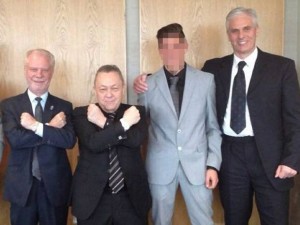
West Ham United co-owners David Gold and David Sullivan give the Hammers salute flanked to the right by crime boss David Hunt
The wealthy co-owner of a Premier League football club made a £1m loan to a company controlled by David Hunt – three months after a High Court judge named Mr Hunt as the head of an organised crime network.
A company owned by David Sullivan, the multi-millionaire boss of West Ham United, lent the money to the East End businessman’s property company soon after Mr Justice Simon concluded that Mr Hunt led a gang involved in fraud, money-laundering and “extreme violence”.
The loan was secured against several of Mr Hunt’s properties, including a golf club in Essex and a restaurant once owned by the actor Sir Sean Connery and the late West Ham captain Bobby Moore, who led England to World Cup glory in 1966.
Mr Sullivan’s company, GC CO NO 102 Limited, made the loan to Mr Hunt’s company in October last year. In January, Mr Sullivan, a former pornography tycoon listed as Britain’s 224th richest man with assets worth £400m, placed this company into voluntary liquidation and declared liabilities of just £90, suggesting the loan to Mr Hunt had been quickly repaid.
David Hunt – nicknamed “Long Fella” – was officially exposed last summer in a judgment by Mr Justice Simon after the crime boss brought an unsuccessful libel action against The Sunday Times.
A catalogue of damning claims emerged during the trial, including allegations that Scotland Yard viewed Mr Hunt’s gang, which had operated with impunity for more than 20 years, as “too big” and “too dangerous” to take on. During a covert operation codenamed Blackjack, the Metropolitan Police placed bugging equipment in a car showroom, which picked up an attack by Mr Hunt in which he had slashed the face of a man named Paul Cavanagh, who had upset an associate.
Mr Hunt was arrested and charged with the attack. But the prosecution dropped the case after Mr Cavanagh withdrew his statement to police. A High Court judge would later find that Mr Hunt had intimidated him into not giving evidence for the prosecution. Mr Justice Simon also concluded that Mr Hunt had attacked and threatened to kill Billy Allen, a property developer, in 2006. “It was the sort of power and authority that might be expected from the head of a criminal network,” said the judge, who also ruled that Mr Hunt had engaged in money-laundering.
Three months after the libel trial had concluded, Mr Sullivan’s finance company made the £1m loan to Mr Hunt’s company, Hunt’s UK Properties. The West Ham co-chairman’s loan was secured against several properties including Woolston Manor Golf Club in Chigwell, Essex. This luxurious setting has twice come to the attention of investigators in unconnected matters. In 2006, Metropolitan Police officers raided the club and found cases of Bollinger champagne which had recently been stolen from a lorry.
Two months after Mr Sullivan’s company made the loan to Mr Hunt’s firm, our sister newspaper The Independent revealed a secret Metropolitan Police report – codenamed Operation Tiberius and dated 2002 – which concluded the crime-lord’s gang had been helped to evade justice by a network of corrupt serving and former police officers.
“The Hunt syndicate has developed an extensive criminal empire which has so far evaded significant penetration from law enforcement,” said the Operation Tiberius report. “The syndicate has achieved this invulnerability through a mixture of utilising corrupt police contacts and the intimidation of witnesses brave enough to give evidence against them.” It added: “The Hunt syndicate is one of the most violent groups in north-east London and has been responsible for a series of vicious assaults against debtors and rivals. Their main sphere of influence is drug importation and protection.”
The report by the Met’s anti-corruption team names four Met detectives “associated” with the syndicate, one of whom is high-profile and has given evidence to Parliament. Operation Tiberius reported that corrupt officers betrayed the Met by telling the Hunt syndicate about tracking devices placed on its vehicles, leaking information about police inquiries and carrying out checks on police intelligence databases. Scotland Yard refuses to comment on Operation Tiberius.
In the same month that The Independent reported details of Operation Tiberius, Mr Sullivan placed GC CO NO 102 Limited into voluntary liquidation.
The 65-year-old made his fortune in pornography magazines and sex shops during the 1970s. In 1986, he founded the Sunday Sport newspaper, offering fanciful stories with headlines such as “World War 2 Bomber Found on Moon”. Mr Sullivan moved into sport with the acquisition of Birmingham Football Club in 1993, appointing Karren Brady – star of The Apprentice, who is close to David Cameron and George Osborne – as managing director. He sold up in 2007 and bought West Ham in 2010.
Mr Sullivan’s club has secured Premier League survival this season under manager Sam Allardyce. In two years’ time, West Ham will move into the Olympic stadium in Stratford, east London, which was built for the 2012 Olympic Games using £500m of taxpayers’ money.
A spokesman for Mr Sullivan said: “GC CO NO 102 Limited is a finance company, it makes loans to numerous people and companies. This was a normal commercial loan at a normal commercial rate.”
A spokesperson for Mr Hunt said: “My client runs a perfectly legitimate property company which, like most property companies, borrows money from time to time from commercial lenders. He has no further comment to make about this matter.”
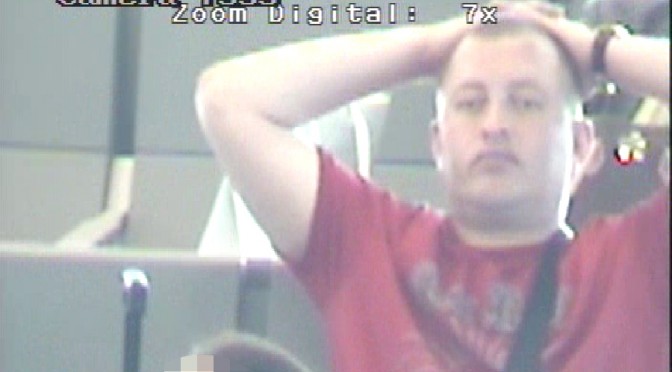
Robert Dawes “the victim” ….I don’t think so and nor do our law enforcement officials
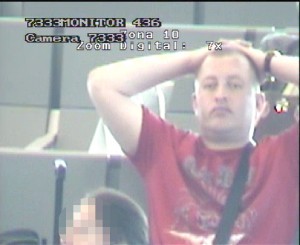 |
| Robert Dawes captured on surveillance cameras at airport |
GANGSTER Robert Dawes has stepped up his campaign to become a newly anointed Saint by creating his own website designed to hit back at some of the material I have published about the man described by law enforcement experts as a “highly significant international criminal”.
The rogatory letter bungle, which I have previously written about in The Guardian , has been resolved and Judge Jose Santiago Torres Prieto has finally received the evidence he had been asking for from the UK’s Serious Organised Crime Agency since April 2011. The cause of the delay of the documents remains a mystery however and although Eurojust, the body based in The Hague responsible for passing on the evidence requests is continuing its investigation into the matter, they have so far refused to provide any explanation.
The Spanish version of the indictment can be read from the following link www.scribd.com/doc/246278845/Spanish-Court-Dawes-indictment

The Teflon Don slips away again
 |
| Robert Dawes is free again. Another botched operation or is something more sinister going on? |
EARLIER this year I wrote about the case of Robert Dawes , head of an organised crime group which has left a trail of devastation in its wake through its activities over the last 10 years.
Dawes was finally arrested in Dubai on an International Arrest Warrant issued by the Spanish authorities and flown to Madrid in May this year. It seemed as though the law enforcement agencies had finally managed to get their man after countless investigations against him dating back more than a decade spanning Holland, Belgium, Dubai, Spain and the UK.
The Spanish were “cock-a-hoop” over the arrest to the extent that they issued a statement saying, in targeting Dawes, they had seized millions of pounds worth of drugs including 5.7 tons of cannabis resin, 100 kilos of heroin, 210 kilos of cocaine as well as four firearms, 5.4 million pounds’ worth of property and 90,000 pounds in cash. They described Dawes as “the boss of one of England’s most important drug trafficking organisations”.
Dawes was placed in custody in Madrid and prosecutors began to finalise their case which centered on the details of Operation Halbert, the SOCA led operation which focused on Dawes which was set up in 2006 and which had already led to three British men and a Columbian being jailed for between seven and half years and eight years in the Spanish courts after 187 kilos of high purity cocaine was seized near Madrid.
Then on September 12 in Madrid a strange thing happened. Dawes was suddenly released from custody by a Spanish judge presiding in Court 32. The officers at the head of the Guardia Civil elite Central Operative Unit which had targeted Dawes were not informed of his release and even a week later the UK’s Serious Organised Crime Agency (SOCA) were denying that the charges against Dawes had been dropped and that he was at liberty. SOCA argued he had merely been released on bail back to his home on the Mijas Costa. Yet there was no surveillance in place for a man known to have several false passports and who has a penchant for fleeing to countries with no extradition agreements such as Dubai. It has since emerged that one of the reasons prosecutors in Spain offered no evidence against Dawes is that one of his associates – British man Karl Hayes who had been interviewed at length by officers from SOCA while in a Spanish prison – was now refusing to make a statement against Dawes.
Returning to SOCA’s role in this matter; it has a number of serious questions to answer about the way this botched operation has unfolded. An official spokesman for SOCA denied their primary role in investigating Dawes. It was, said a spokesman, a “Spanish operation” which SOCA simply assisted “where required” . That is a strange assertion in itself since, according to documents filed in the Spanish courts, SOCA was the lead agency on Operation Halbert and the main involvement of the Spanish authorities was in making the initial arrests on their soil, seizing the cocaine and subsequently applying for Dawes extradition from Dubai. All the intelligence for the operation came from SOCA including the tracking of vehicles, and if SOCA had no primary role in this investigation why did its officers fly out to Spain to interview one of Dawes’ associates Karl Hayes a number of times?
And what are we to make of the Spanish courts statement on Robert Dawes release. This is what they had to say.
“The Provincial Court in Madrid has revoked the indictment of Robert Dawes issued by the Court of Instruction number 32 and so he is at liberty. The magistrates at the Provincial Court understand that, over and above the important report by the Central Operative Unit (of the Guardia Civil) which is found in the proceedings, it is necessary to wait for a response from the Commission of Dubai, with reference to the searches in the case, and, above all, the Commission of the United Kingdom. When the judicial authorities of those countries respond with evidence the case will be taken up again, but neither of the two commissions has yet commented and there is no indication of when they might do so.”
So in effect Spain is blaming the UK for failing to provide it with the evidence it had requested to keep Dawes in custody.
Robert Dawes has been identified in no less than nine large national criminal investigations in the UK involving large scale drug shipments since 2000. In addition he has been identified by Nottinghamshire Police as the man suspected of commissioning the murder of David Draycott, in Sutton-in-Ashfield, Nottinghamshire in October 2002, a case in which no-one has been charged. Additionally, Dutch investigators have evidence that Dawes sponsored a similar hit against an innocent school teacher, Gerard Meesters in Groningen, Holland in November 2002. As recent as late last year a SOCA document described Robert Dawes as “a highly significant international criminal” and in the prosecution of Dawes brother John, who received a 24 year sentence for drug supply and money laundering, Robert Dawes was named as the head of the organisation.
When Dutch investigators visited the UK in 2004 to speak to potential witnesses with intimate knowledge of Dawes’ drug smuggling and money laundering operations, those witnesses all pointed the finger at Dawes saying they believed he had ordered Gerard Meesters murder. None would make a formal statement to Dutch prosecutors fearing reprisals. Some went further. Dawes, they believed, was an “asset” who was being protected in some way from prosecution because of the information he held. A statement they said, implicating Dawes, would not be conducive to their long term health if a prosecution failed. Even police officers who have investigated Dawes in the past are coming to the conclusion that Dawes is a “Teflon Don” to whom no prosecution will stick. Whether this is true or not remains to be seen but the latest twist in the life of this latter day Godfather does nothing to debunk the theory that some hold that Dawes is in some way being protected. At present Robert Dawes’ criminal CV appears to be an example of 11 years worth of clumsy law enforcement work or someone somewhere has been placing spanners in the works deliberately.I am told the Spanish authorities now have no idea where Dawes is. Either way at present Robert Dawes appears to be bullet-proof as far as our law enforcement agencies are concerned and I hear that he is even lining up a 200,000 Euro claim against the Spanish authorities for wrongful arrest. Priceless.

